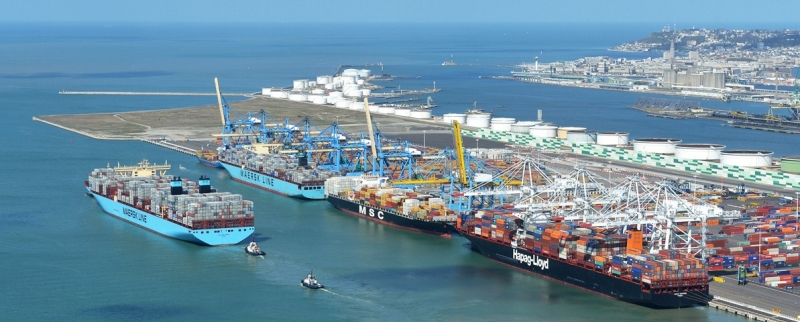The Supervisory Board of the Port of Le Havre which met on 26 March 2019 has welcomed the good financial results for 2018, which demonstrate a significant improvement in the port’s situation and the restoration of its internal financing capacity. The balance sheet allows the port to carry out the ambitious investment programme voted in 2018 and to consolidate its development as part of an integrated complex all along on the Seine corridor.
The port posts its excellent financial situation
This situation is due – and in the same proportions – to the growth in turnover, the control of its expenses and the support of the State. The increase in turnover, which stands at € 195 million for 2018, reflects the effectiveness and relevance of the pricing policy set up, particularly with regard to the new public property policy adopted by the port of Normandy. The cash flow from operations exceeds the target set by the strategic project and stands at € 55 million for 2018: a result that has tripled in the last five years. The cash flow-to-debt ratio, which indicates the number of years needed to repay the debt, is also improving: 3 years in 2018 against 13 years in 2013.
The € 600m investment program continues
The favourable financial situation, which is in line with the growth in traffic (+2% in 2018), puts the port in a good position and reinforces its attractiveness to carry out its ambitious investment programme.
For the record, this program of € 500 million, raised to € 600 million due to the development of the wind farm project, was unanimously decided last June by the members of the Supervisory Board further to the recommendation of the report submitted by the Guarantor after consultation with all the stakeholders, which concluded on the relevance and prioritization of the investments necessary for the development of the Port, including the completion of Port 2000:
the development of berths 11 and 12 of Port 2000 has therefore been launched: the Supervisory Board, after having read the motion of the Development Board, unanimously confirmed the procedure initially initiated and recalled that the results of this procedure are to be presented to the Supervisory Board for a decision in June 2019. The purpose of this decision is not to delay the timetable for what has been unanimously recognized as the most strategic investment for the further development of the port.
river access to Port 2000 (the ‘flapgate’), which was the subject of a public consultation last year, is going ahead: the Port of Le Havre welcomes the decision of the European Commission to allocate € 25m as part of the 2018 Transport Call for Proposals for the Connecting Europe Facility (CEF). That support, announced on March 26, is fully in line with Europe’s approach to encouraging projects that promote multimodal development. It allows us to complete the financing of this infrastructure: 20% of the total cost of the project will therefore be borne by Europe and the remaining two-thirds will be provided by the Port of Le Havre (11% or € 13.75 million), the French government (3% or € 3.6 million) and the Regional Council (66% or € 82.65 million). The complementary studies (especially on the environmental issues) are in progress; applications for building and operating permits could be filed in 2020 with work beginning in 2021 and start of operation in 2023.
The multimodal terminal continues to progress
The multimodal terminal consolidated its development in the first months of 2019. These good results follow the 7% growth recorded in 2018 compared with 2017. The Supervisory Board has decided to launch an RFP for a public service concession involving the integrated operation of the multimodal terminal, the transfer system and the management of the related services; the challenge is to provide outlooks for growth and give long-term visibility to the future operator of the system.
Le Havre, 43% of France’s foreign trade in market share
Hinterland full container traffic for the Port of Le Havre has been growing steadily for 10 years (+27.4%), against a background marked by the weak dynamism of “containerizable” French foreign trade with third countries (those outside the EU). This growth in traffic is mainly driven by exports, in particular to North America (+54%), but also to Africa (+49%), South East Asia (+48%) and Central America (+38%).
HAROPA’s market share in France’s foreign trade with third countries is higher for exports (50%) than for imports (40%), consistent with the shipping services offer in Le Havre, which highlights its positioning as the “last port call for exports” (3.5 times more transoceanic services choose a port call in Le Havre as the “last port for exports” rather than the “first port for imports”). There has been a resumption of imports since 2017, which coincides with the renewal of the offer of alliances on the main east-west trades.
These good results and the ongoing investments represent a real asset for the creation of a sea and river port establishment on the scale of the Seine corridor. It should be recalled that in January, French Prime Minister Edouard Philippe appointed Catherine Rivoallon to prefigure the future public enterprise. To carry out that task, Ms. Rivoallon relies in particular on a prefiguration committee: chaired by Valérie Fourneyron, the committee includes Thierry Tuot, State Councillor, Gilles Belier, lawyer member of the National Council for Labour Relations, Frédéric Henry, Chair of the Supervisory Board of the Grand Port Maritime of Rouen, and Emmanuèle Perron, Chair of the Supervisory Board of the Grand Port Maritime of Le Havre. It is for this reason that Emmanuel Perron is taking part in the work involved in setting up the future enterprise.orts” (3.5 times more transoceanic services choose a port call in Le Havre as the “last port for exports” rather than the “first port for imports”). There has been a resumption of imports since 2017, which coincides with the renewal of the offer of alliances on the main east-west trades.






